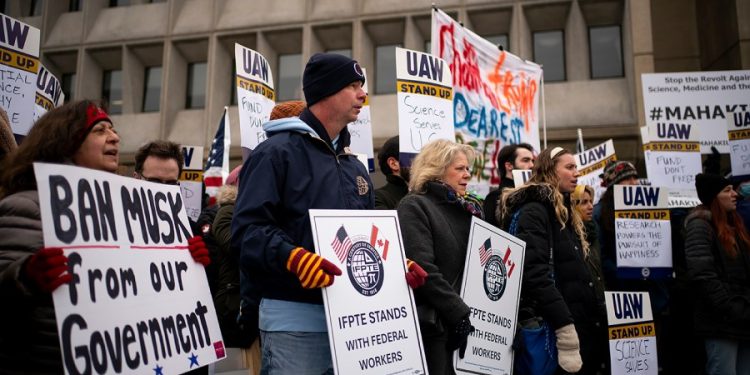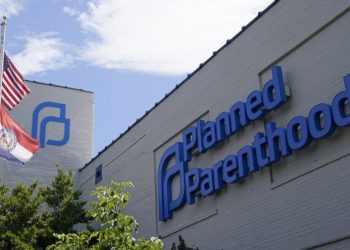The Department of Health and Human Services (HHS) launched a war on labor unions representing its workers when it announced last week it would be derecognizing representation in several offices.
Although labor representatives maintain this move was illegal, a recent federal court decision paved the way for derecognition, at least while legal battles play out in court.
The HHS said Friday it would no longer be recognizing union representation within several offices by the National Treasury Employees Union, American Federation of Government Employees (AFGE), National Alliance of Postal and Federal Employees, and the United Automobile, Aerospace and Agricultural Implement Workers of America.
“We contend that the termination of our contracts is illegal, but obviously that’s still being debated in the courts. The lifting of the preliminary injunction on Aug. 1 is what prompted HHS and other agencies to sever their contracts,” Tim Kauffman, AFGE communications specialist, told The Hill.
Labor unions filed a lawsuit in April seeking to block President Trump’s executive order blocking federal workers from accessing union rights. On Aug. 1, a three-judge panel for the 9th Circuit Court of Appeals rejected the argument by the plaintiffs that Trump had issued the order in retaliation, overturning a lower court’s ruling blocking the derecognition.
The panel — composed of one former President Obama appointee and two Trump appointees — found that lifting the injunction would “serve the public interest by ‘preserving the President’s autonomy under a statute that expressly recognizes his national-security expertise.”
But that same order urged the federal government to hold off on ending collective bargaining agreements until “litigation has concluded.”
The HHS isn’t waiting. Kauffman declined to discuss what the AFGE’s legal strategy will be going forward.
Under the authority of the Civil Service Reform Act of 1978, the president can stop collective bargaining at agencies that work on issues of national security — a caveat the administration argues covers public health.
HHS spokesperson Andrew Nixon said derecognition would ensure that “personnel are fully focused on safeguarding the health and security of the American people.”
“By implementing President Trump’s Executive Order 14251, HHS is removing unnecessary obstacles to mission-critical work and space previously used for union activities,” Nixon said when the announcement was made.
“This change strengthens our ability to respond rapidly to public health threats, advance national security, and deliver results for the American taxpayer.”
In their original complaint, labor unions argued Trump’s claim that derecognition was necessary for national security reasons was a misdirection. They argued his decision was retaliatory, as these unions had sued to block his administration’s far-reaching layoffs. Trump had referred to “hostile Federal unions” when he issued his executive order to derecognize unions.
“The Fact Sheet specifically referenced a statement by the ‘largest Federal union’—i.e., Plaintiff AFGE—that it was ‘fighting back’ against President Trump’s policies,” the complaint read. “To further drive home the retaliatory intent of the Exclusion Order, the White House Fact Sheet concluded with the message ‘President Trump supports constructive partnerships with unions who work with him.’”
Tamara Slater, an attorney at Alan Lescht and Associates, a law firm that represents federal workers in contract disputes, said the jury’s still out on whether Trump can truly derecognize unions in this way.
She said courts are yet to grapple with the fundamental questions about the government’s powers to suppress union rights.
“We’re not really in the phase of final decisions. We’re in the phase of, ‘Can there be protective orders? Should there be stays to certain agency actions?’ So, it seems very likely that decision to derecognize the unions, at least, will go ahead. Now, whether in two years time courts find that it’s illegal or not, it’s hard to say,” she said.
Slater’s firm is not involved in the labor unions’ lawsuit against the federal government.
She questioned the government’s legal rationale for the decision.
“It’s not clear to me that this national security carve-out is actually being applied properly and narrowly,” she said.
Slater noted that many unions have said they plan to stay active despite this recent decision, and she advised federal workers to keep in touch with their unions despite being derecognized.
This isn’t the first time the Oval Office has moved to decertify a union representing federal workers.
The first and perhaps most notable instance of this was when former President Reagan — whom Trump has frequently compared himself to — fired more than 11,000 striking workers represented by the Professional Air Traffic Controllers Organization (PATCO) in 1981, banning them from being rehired.
Later that same year, the Federal Labor Relations Authority decertified PATCO.
Today, federal workers still have some protections they can turn to in the absence of union representation. The U.S. Merit Systems Protection Board, which was also established through the Civil Service Reform Act, and the Equal Employment Opportunity Commission are among the offices available to federal sector workers.
These coexisting protections can complicate matters, however.
“There are all of these administrative protections available to federal employees that federal sector unions sort of have to work around and work with,” Slater said.
For employees of derecognized unions, she said this may mean they need to turn to these administrative forums with grievances or appeals that would previously have been made through the union.














